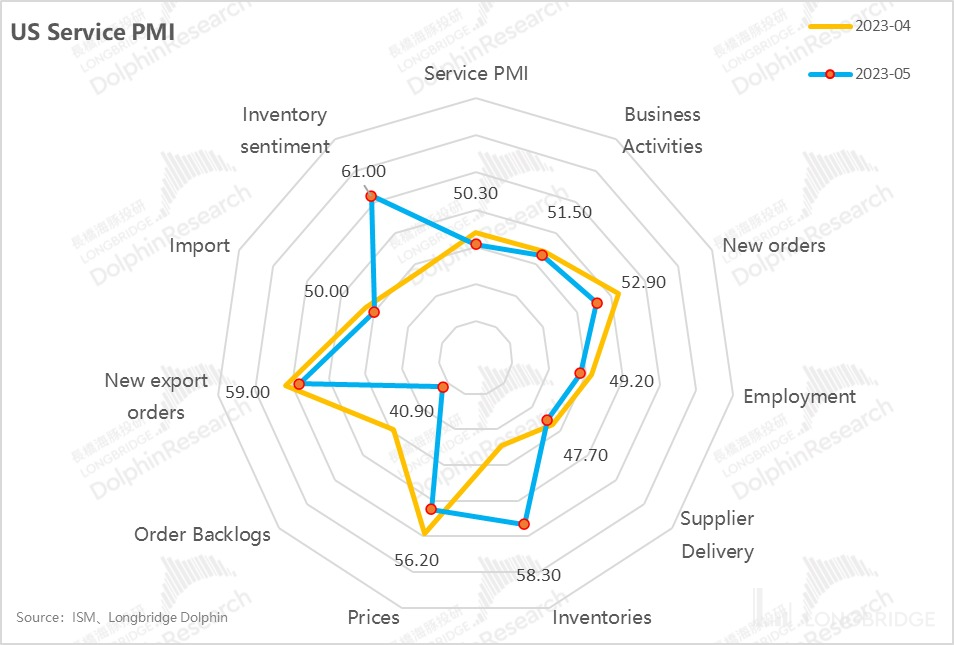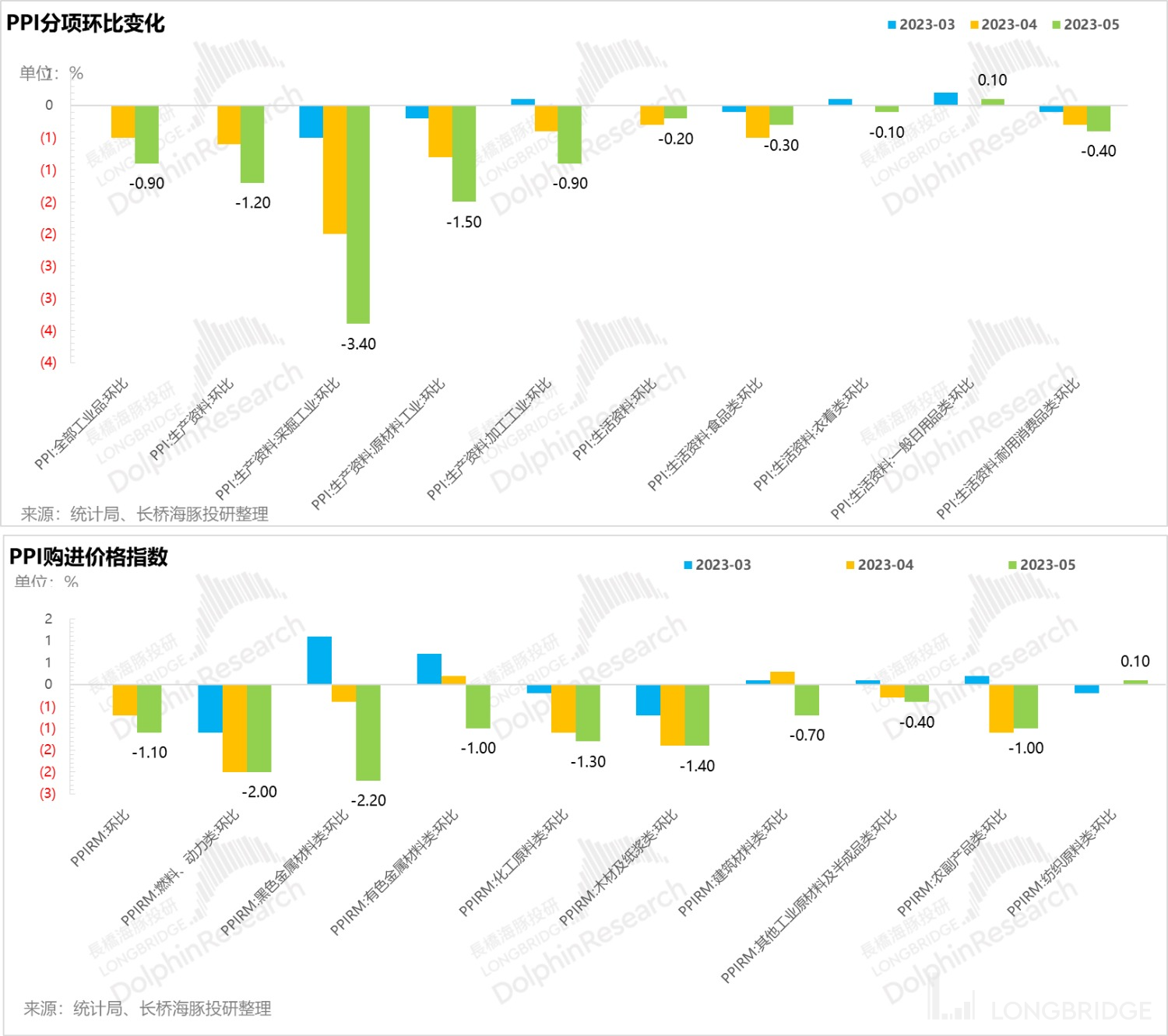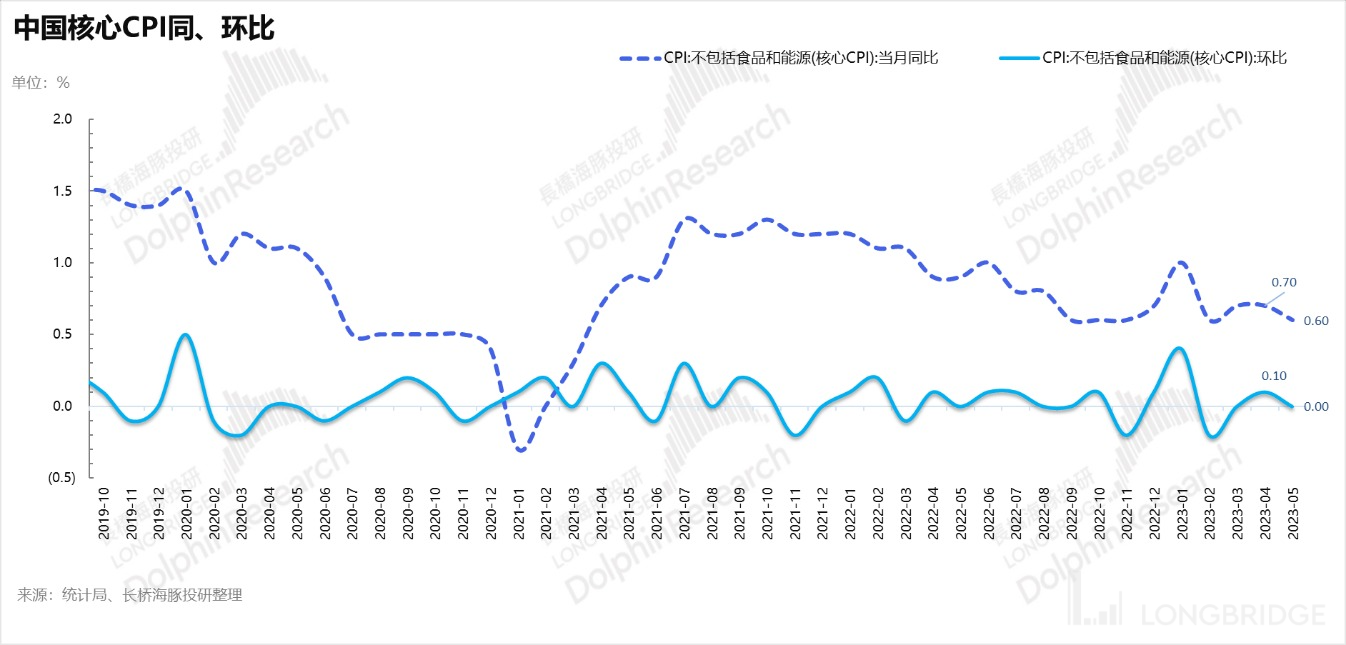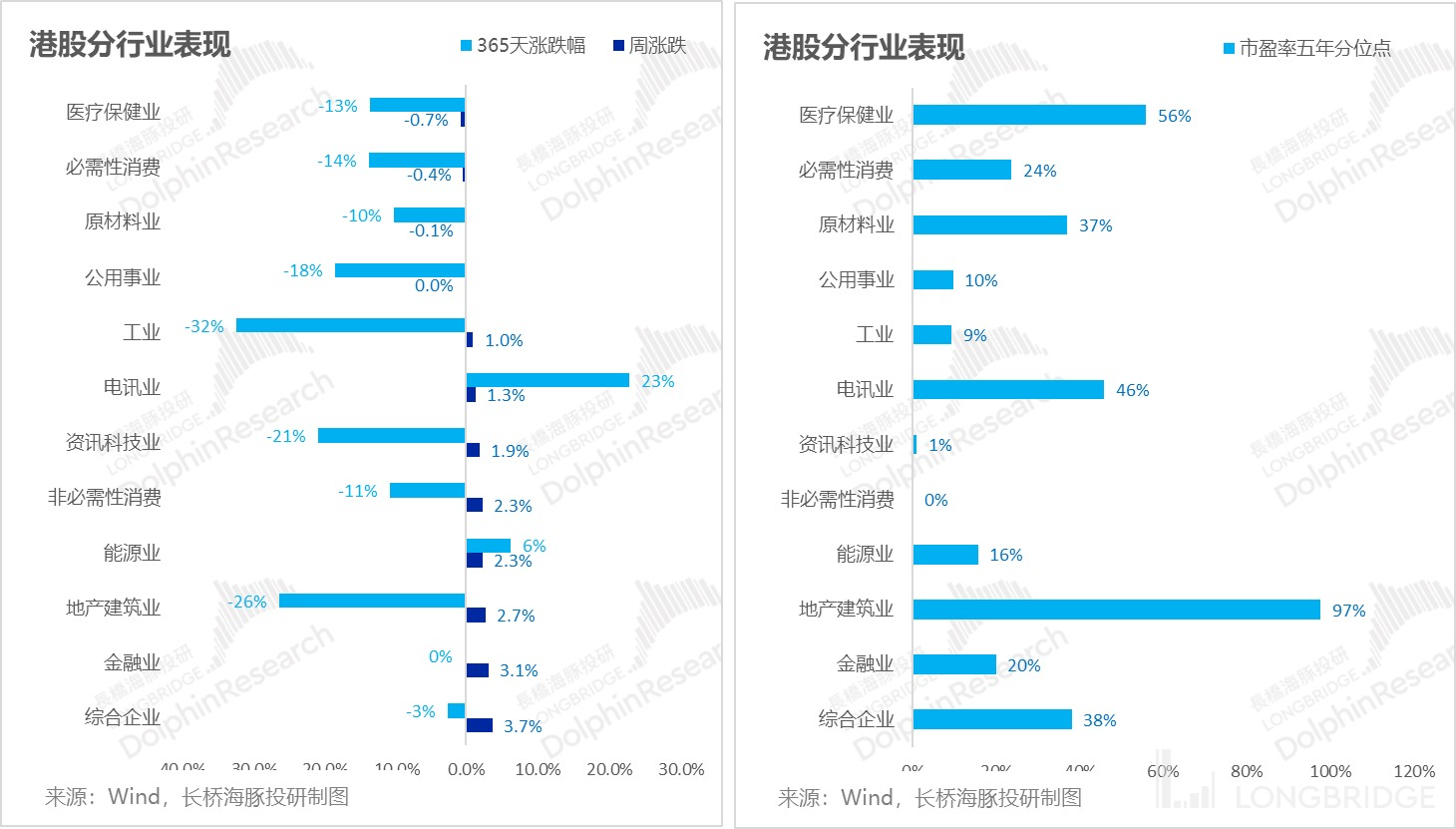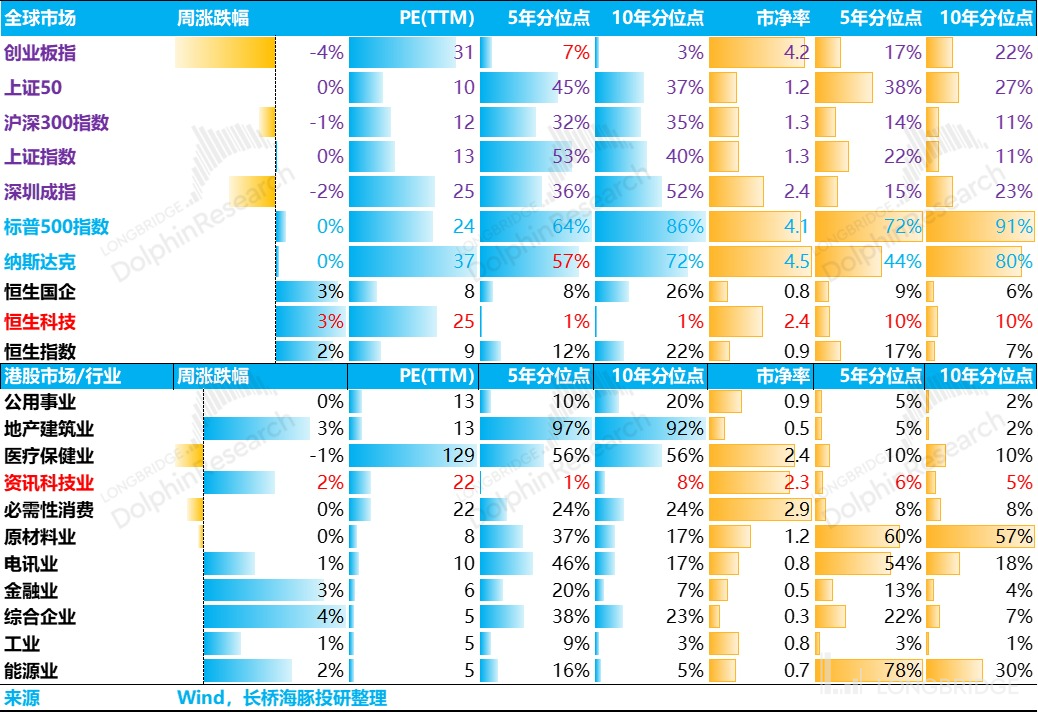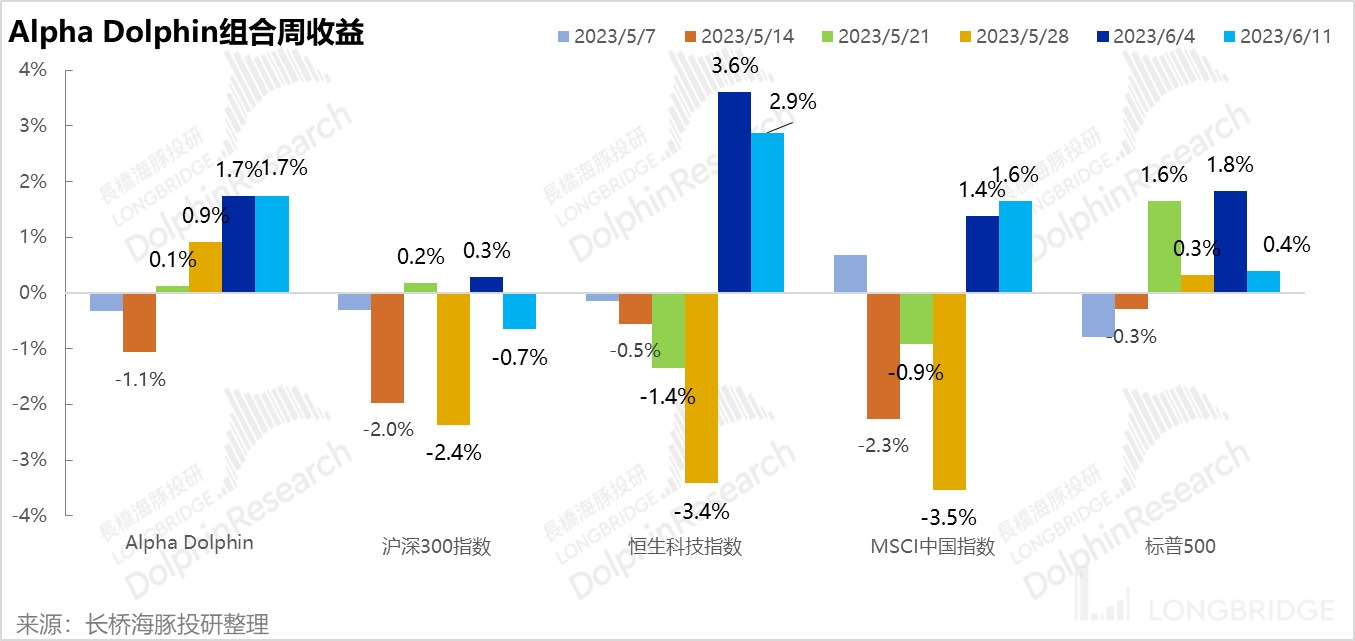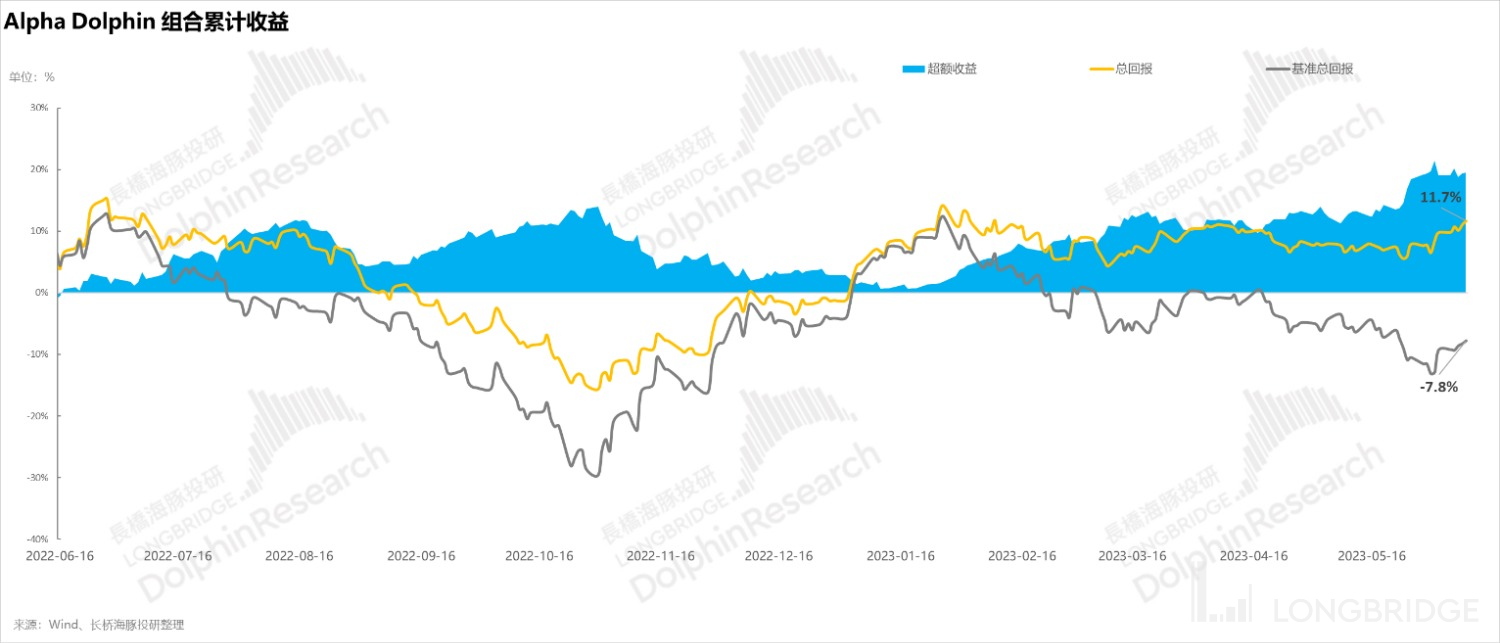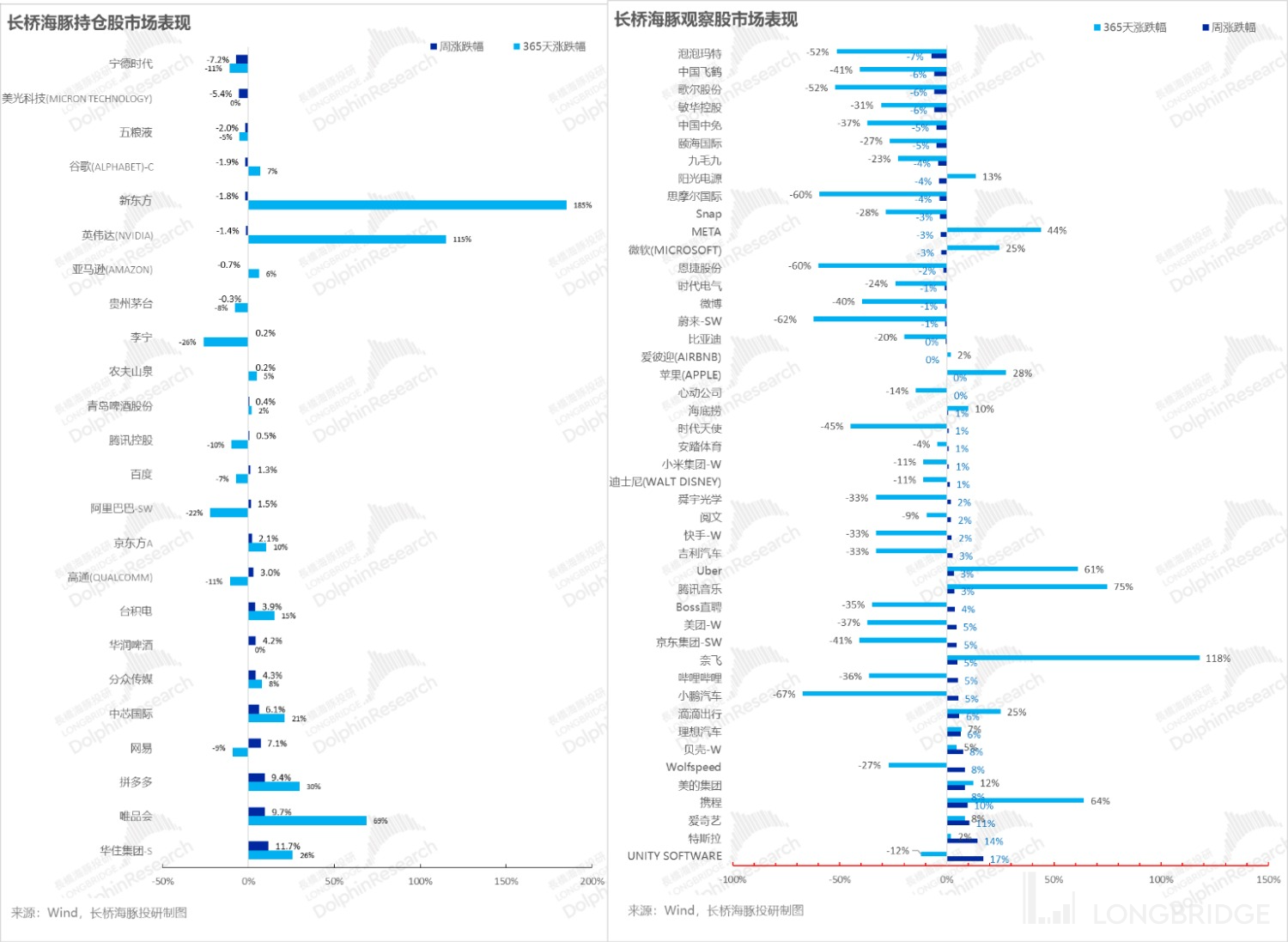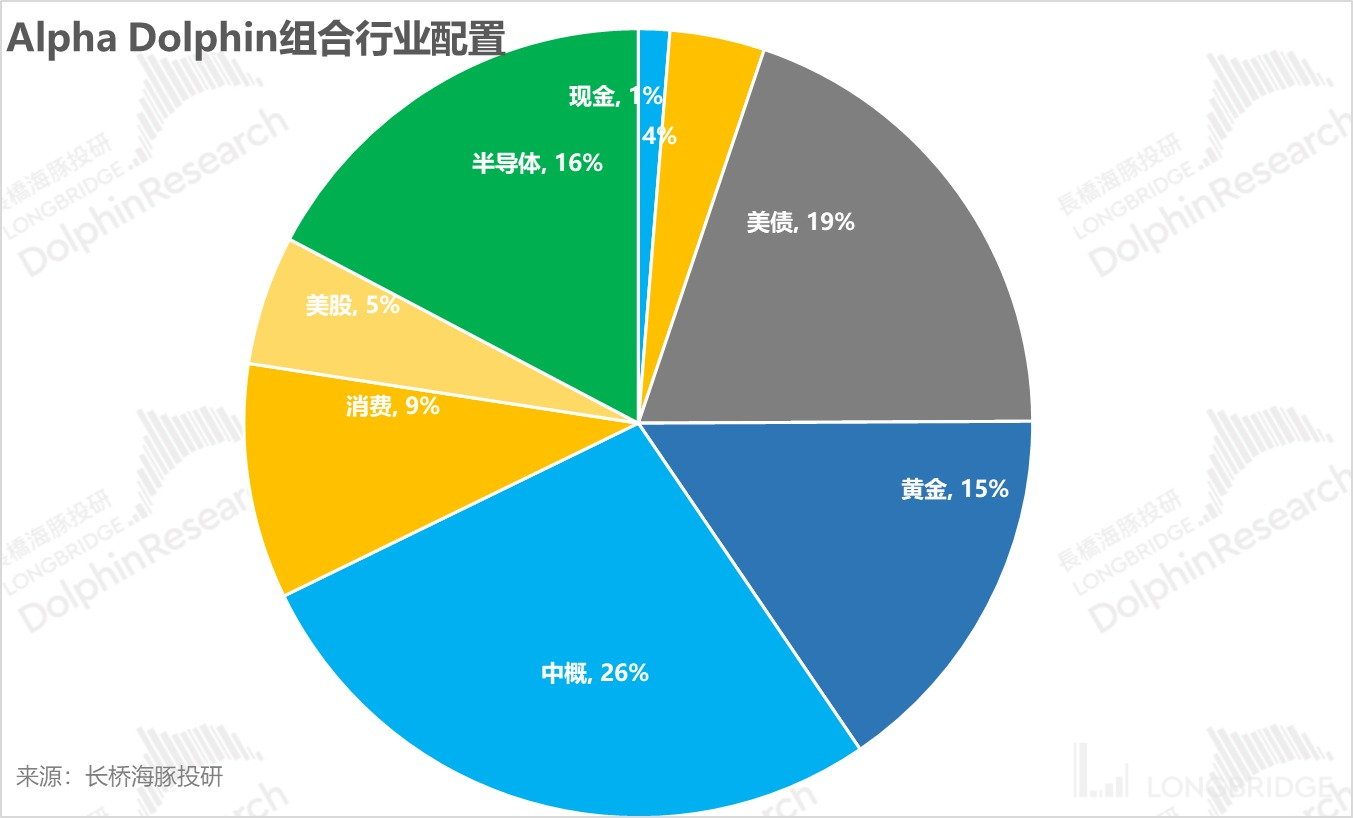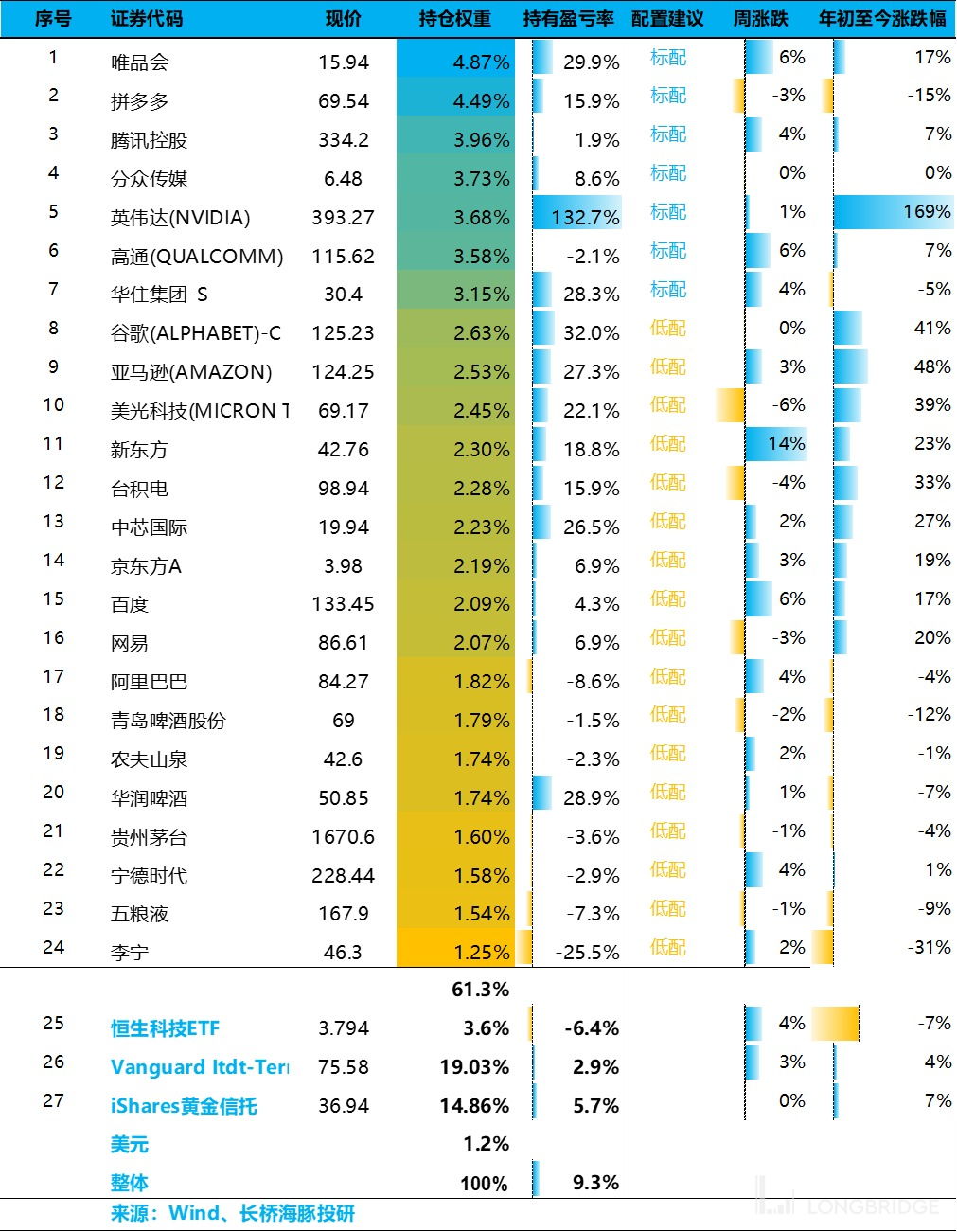小作文左右市场?悲观过头的修正才是灵魂
Hello everyone, below is the core information of the combination strategy summarized by Dolphin this week:
1) US Service PMI "Changes": The marginal changes in orders and inventory imply that downstream demand has weakened, quickly consuming order balances, while excessive stocking has led to a rapid increase in inventory. This is corroborated by the marginal decline in service prices and service employment PMI sub-items. This data can be observed for several months. If the trend continues, it is likely to mean that even if employment in May is still strong and can support the US economy in May, the turning point of service employment is also coming soon. Both manufacturing and service PMIs have deteriorated, implying that the US economy still has problems.
2) Continuous Trading, Risk of "No Recession" in the US Economy: As of last weekend, after technology stocks were too expensive to climb, the US stocks have continued to catch up with cyclical assets for two consecutive weeks, and continuous trading and interest rate suspension have led to "no recession" in the US economy. This trading logic that ignores the marginal changes in PMI needs to consider possible risks in the future.
3) Domestic Prices and Exports "Expected Weakness": Domestic demand has entered the "weak deflation" trading since April, and the prices and export data in May only indicate that the current demand is indeed weak. In the current situation where the valuation percentile is significantly lower and there is still policy tool space, the cost-effectiveness of continuing to short Chinese assets is already very low. In addition, Chinese concept stocks that are undervalued and whose profits are gradually released have started to repair their valuations. Hong Kong consumer stocks have also begun to stabilize. Subsequent domestic focus will include possible policy hedging, including interest rate cuts.
4) Following the reminder of Dolphin two weeks ago that May entered a new period of macroeconomic variable releases, the relative valuations of Chinese and American assets have been fully adjusted, and the newly adjusted Chinese concept assets have continuously pulled the combined income for two consecutive weeks, offsetting the drag of the stagnant technology stocks in the US. Last week, VIPSHOP, Pinduoduo, and NetEase contributed significantly. In addition, the situation of Huazhu's fundamentals is not bad, and the stock price has been significantly repaired last week, ensuring the relative excess returns of the virtual portfolio (Alpha Dolphin portfolio up 1.7% vs MSCI China up 1.6%, S&P up 0.4%).
The following is the detailed content:
Last week, the United States was basically in a macro silence period, and the only thing that was relatively valuable was the service PMI, while China had two heavyweight data released, CPI/PPI and export data.
I. US Economy: Is the Service Industry Turning Cold?
Although US service employment is booming, it is a lagging indicator, and as a forward-looking indicator released last week, the May service PMI clearly had problems:
Although the May service PMI is still in an expansion state, several key sub-items have begun to deteriorate marginally, especially employment has directly entered the contraction zone; the most critical change is still in the trend of inventory and orders:
In the case of faster supplier delivery speeds, the inventory of service industry orders is being rapidly consumed (contracting by nearly 9 percentage points to less than 41%), but the expansion speed of new orders, including new export orders, has slowed significantly (down 3 percentage points to 53%). This led to a significant expansion of inventory for service enterprises in May, with a clear indication of passive stockpiling. The inventory sentiment rose from 49% to 61%, indicating that service industry enterprises realized that their inventory preparation was excessive and far exceeded market demand.
In the United States, the commodity production and service production, which are the two major employment categories, are distributed in such a way that mining, construction, and manufacturing, which make up commodity production, contribute to less than 17% of non-agricultural employment in private employment in the United States. Over 80% of non-agricultural private labor force is absorbed by the service industry.
The post-epidemic employment demand mainly comes from the more vigorous private service demand, especially in the transportation industry, healthcare industry, and temporary support positions.
If the service PMI continues to shrink, especially if the inventory level relative to demand exceeds rapidly, it may indicate that the problem of insufficient supply of service industry employment is approaching a turning point.
Of course, it is not enough to judge only by the change in the monthly service PMI. It is necessary to observe employment for another one or two months. If the inventory and order items of the service industry continue to deteriorate, it basically means that the fundamental driving force of the post-epidemic prosperity in the United States, service consumption, has been exhausted.
Since only the forward-looking indicators of service and manufacturing PMI have deteriorated in the economic data released by the United States, and the most critical lagging data, May employment, is not bad, the main trading line in the US market is still "no economic recession".
-
The overall technology stocks in the US stock market are currently overvalued and have lost their cost-effectiveness, showing a stagnant rise or even a slight correction;
-
However, in the industry sectors, optional, public utilities, energy, industry, and even cyclical stocks such as finance and real estate are gaining momentum. In the past two weeks, the US stock market has ignored the recession signal transmitted by the PMI and has begun to truly price in the expectation of no economic recession in the United States.
Last week, the yield on US long-term bonds hardly fluctuated. From the perspective of bond market trading, the market continues to price in no interest rate cuts within a year, and even a slight possibility of interest rate hikes.
2. Domestic economy: It's time to wait for policy redemption again
The problem of domestic demand deflation has been widely brewing since the release of the March CPI (YoY 0.7%) in early April. By the time the May CPI data came out last week, the problem of sluggish demand had been fully traded.
Both essential and optional consumption have declined significantly, even including sectors such as tourism and catering that have shown obvious recovery after the epidemic. After being hit across the board, the trading expectation has become fully pessimistic, so the softness of prices is basically within expectations.
-
There is no obvious sign of a rebound in MoM PPI, especially for production materials PPI. Combined with the fact that the decline in the purchasing price index in PPI is slightly lower than the decline in material prices, industrial enterprise profits are likely to remain under pressure.
-
There are signs of a slight recovery in the decline of living materials related to terminal consumption in PPI, especially in the food category, but durable living materials are still accelerating their decline without support.

- Although YoY CPI seems to have recovered slightly, from a YoY increase of 0.1% last month to 0.2%, MoM is actually getting worse: the core CPI excluding food and energy has changed from a positive growth of 0.1% in April to 0% growth.

Details of the MoM changes in core sub-items:
-
The slight recovery in the decline of goods is mainly due to clothing, with clothing and footwear products both showing positive growth MoM. Other items such as household appliances, transportation tools such as cars and mobile phones are still declining MoM.
-
The MoM decline in living costs is 0.1%, and the poor housing market has also affected the rental market expectations. We can observe whether there will be any recovery during graduation season.
-
Among the service prices, as May is the peak season for tourism, the price of tourism services has changed from a MoM increase of 4.6% in April to a MoM decrease of -0.1%. One possible explanation is that May Day tourism bookings were made in April, and after May Day, tourism prices fell. In addition, as a major sub-item of services, transportation services continue to deflate due to low car prices, fuel prices, and even labor costs.
Overall, from the composition of core CPI, we can see that living and automobile consumption continue to be weak, and post-real estate cycle consumption such as electricity and furniture is also weak. Currently, only clothing consumption has slightly recovered, slightly supporting the MoM decline in commodity consumption. As for service consumption, after May Day, the prices of tourism products and other items have also fallen.
Overall, the price side still reflects the state of oversupply and weak demand in the domestic supply and demand pattern. Moreover, if car prices, prices of electrical products, transportation and tourism prices continue to fall, there is a possibility of negative growth in MoM core CPI, and the worst time for prices may not have arrived yet.

Although prices are poor, they are basically within market expectations. In the current market where the expectation of "Chinese asset decline" has been fully reflected, the trading perspective should instead focus on policy hedging, especially in the case of continued low prices and rising real interest rates, there may be expectations of interest rate cuts in the future. This week, China will release a series of macro data, including RMB loans, social financing, fixed asset investment, retail sales, and industrial added value. The US will release CPI (Tuesday)/PPI (Wednesday), the Fed's interest rate decision on whether to pause or raise interest rates, and retail sales data.
Based on the PMI data from the US, there are signs of weakness in the US service consumption, but due to good employment support, US retail sales are likely to remain stable in May. At the same time, if the CPI data does not show a clear trend of rising MoM inflation, the Fed is likely to pause and wait for the high interest rates to gradually penetrate into the real economy.
In China, the focus is mainly on social financing data, whether there are signs of policy force, and whether the speed of household deleveraging has slowed down.
Where is the market trading?
After Dolphin increased its holdings in Chinese concept stocks, Hong Kong stocks continued to recover, but the recovery is still behind the policy game. For example, the 30% weight sector-financial industry recovery is related to the reduction of deposit rates for residents, while the real estate and construction industry is related to various small essays.
In this round of Hong Kong stock market sell-off, the implied heavy selling of growth expectations is not bad in terms of current profits. Even some indexes of A shares have fallen to a low position of nearly five-year valuation percentile. In the case of relatively sufficient policy tools in China, the cost-effectiveness of continuing to short Chinese assets is very low.
Portfolio returns
On the week of June 9th, the Alpha Dolphin portfolio did not adjust its position. This week, the Alpha Dolphin virtual portfolio rose by 1.7%, slightly outperforming the MSCI China Index (+1.6%), the CSI 300 (-0.7%), and the S&P 500 Index (+0.4%), but not as good as the Hang Seng Tech Index (+2.9%).
Since the start of the portfolio test until last weekend, the absolute return of the portfolio was 12%, and the excess return compared to the MSCI China was 19.5%. V. Contribution of Individual Stocks to Profit and Loss
Last week, the portfolio's returns continued to be driven by the Chinese assets, VIPshop, Pinduoduo, and NetEase, which were added during the last rebalancing two weeks ago. In addition, the oversold stock, Huazhu, which was suspected of being wrongly killed off previously, showed significant recovery last week. The main drag on the portfolio's composition last week was the stagnant US tech stocks and Ningde Times, which is known for its ghost stories in China. After several weeks of adjustment, consumer stocks finally showed signs of stabilization.
Observing the US stocks in the portfolio that have risen sharply, most of them are driven by company-specific events. For example, Unity's cooperation with Apple's headsets, Tesla's full subsidy for Model 3, and the new heavyweight customer for its charging station network.
Most of the Chinese assets in the portfolio that have risen are mainly due to undervaluation recovery, with the exception of Ctrip. Ctrip should be attributed to the last rebalancing of the Dolphin, with no flaws in its fundamentals and a reasonable valuation (the same reason for adding Pinduoduo). According to the Dolphin's estimated target price of $40, there is still about 15% upside potential when the financial report is released, and Ctrip can still be watched for opportunities in the future.

The specific reasons for the rise and fall of the companies that are at the forefront are summarized by the Dolphin as follows:
VI. Distribution of Portfolio Assets
There was no rebalancing in the portfolio this week, with a total of 21 stocks or ETFs allocated, including 7 standard-rated and 19 low-rated stocks, as well as gold, US bonds, and US dollars.
As of the end of last week, the Alpha Dolphin's asset allocation and equity asset holding weights were as follows:


Please refer to the following articles in the recent weekly reports of Dolphin's investment research portfolio:
"Purgatory vs. Frenzy, What Are the US and Hong Kong Stock Markets Really Trading?"
["US Stocks Pulling Valuations, Hong Kong Stocks Killing Beta? Don't Despair, Reversal Is Coming"](https://longportapp.com/zh-CN/topics/6328947? app_id=longbridge&channel=t6328947&invite-code=276530)
《Putting high interest rates into another bank? The chance of a soft landing is even greater》
《ChatGPT vs Performance Ranking, Can Giants Support the US Stock Market?》
《The promised "US recession, China's recovery", is it going to fail?》
《The collapse of US service consumption, and the celebration of the US stock market?》
《Fed rate cut: Just waiting for a moment when the US version of Yu'ebao attacks?》
《Silicon Valley Bank's run on crisis: Is the US recession going to run to the scene?》
- "美股回吐完交易抢跑,全球终能喘口气"
- "通胀抬头实锤?否极泰来反是机会"
- "通胀暂放一边,阿里和百度里的信号更重要"
- "港美齐齐弱鸡,狼又要来了?"
- "高频宏观的牵线木偶,美股是傀儡市"
- "一根阳线改信仰,特斯拉带领美股杀回来了?"
- "美股 “危”“机” 变局还有多远"
- "美股没有过年红,但业绩锤却近在眼前?"
- "扒一扒美股滞涨的根源"
- "CPI 已经回落,美联储为何还是这么轴?"
- "服务通胀真有那么容易消灭吗?小心市场矫枉过正"
- "港股终于有 “腰杆” 了?独立行情还能走一段" “The Darkest Hour Before Dawn: The Importance of the Dark or the Dawn Attitude”
"US stocks 'hitting back' at reality, how much longer can emerging markets bounce?"
“Global valuation repair? There is still a hurdle of performance verification”
“Why Are Chinese Assets Surging While China-US Relations Are Ice and Fire?”
“Amazon, Google, Microsoft's stars falling? US stock 'meteor shower' still to come”
“Policy shift expectations: unreliable 'strong dollar funds' and GDP growth?”
“The moment of testing 'determination' for southern acquisitions vs northern runs”
“Slowing rate hikes? The American dream shatters once again”
"Reacquaint with a 'Iron-blooded' Federal Reserve"
"Sad Second Quarter: 'Hawkish' Voices Loud, Exodus Hard"
“When you fall into doubt and despair, is there still hope for a reversal?” 《Did the Fed's aggressive stance on inflation create opportunities for domestic consumption?》
《Global markets are falling again, and the root cause is the shortage of workers in the United States》
《The Fed has become the number one bear, and global markets are collapsing》
《The interest rate hike enters the second half, and the "performance thunder" opens》
《China's current assets: "No news is good news" for US stocks》
《Growth is already in a frenzy, but is the United States really in decline?》 《2023 年的美国,是衰退还是滞涨?》
Risk Disclosure and Disclaimer of This Article: Dolphin Investment Research Disclaimer and General Disclosure




